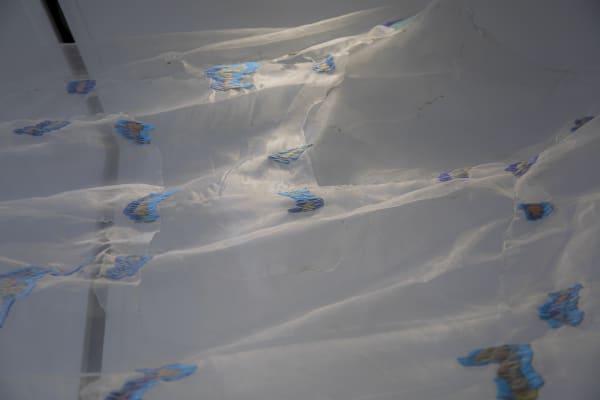Pre-revolutionary icon cases from Orthodox icons for me are a frame for the emptiness and loss of our era, and a symbol of the tacit question of what a person, civilization, culture is and where we should go now, what to be.
Voskhod Gallery is pleased to announce its first physical exhibition and public gallery space with the installation Noah by Fedora Akimova.
In her work, whether painting or installations, Fedora explores imaginary mystic worlds that feel cold and give us a sense of anxiety and alienation. These worlds are inhabited by animals that are either extinct or not real and there is no human in sight. Have humans gone or did they never exist? Religious symbols that should offer secret or sacred meanings instead symbolize emptiness and remind us of empty shells.
The whole of Fedora’s practice leaves the viewer a bit disturbed with a feeling that something big and inevitable has just happened, a global catastrophe, that might be result of man’s presence, his destructive existence.
In her latest project, Noah, Fedora again places us in her post-human world, however also gives us an opportunity to contemplate our chance for salvation.
* The Organza veil with handmade embroidery was created with the support of the Garage Museum of Contemporary Art.
In her works, whether painting or installations, Fedora explores imaginary mystic worlds that feel cold and give us a sense of anxiety and alienation. These worlds are inhabited by animals that are either extinct or not real and there is no human in sight. Have humans gone or did they never exist? Religious symbols that should offer secret or sacred meanings instead symbolize emptiness and remind us of empty shells.
The whole of Fedora’s practice leaves the viewer a bit disturbed with a feeling that something big and inevitable has just happened, a global catastrophe, that might be result of man’s presence, his destructive existence.
In her latest project, Noah, Fedora again places us in her post-human world, however also gives us an opportunity to contemplate our chance for salvation.
The project explores the problem of discrediting universal human values and illusions that have been built for millennia. We all know the bible story of Noah which, like the rest of the Old Testament, explores the chance for salvation. Looking at the plot from our present, one can see many new, more utopian meanings, and this can become a story of a failure to save and be saved. Man now needs to be saved first of all from his anthropocentric, barbaric illusions and the consequences of his own actions.
The central part of this installation is an icon case (a “kiot”), as a cultural code of Orthodoxy, which once was the uniting religion for many slavic nations. A huge, hand-embroidered canvas is connecting pieces of transparent matter that were once an integral universe. Criticism of the Anthropocene Epoch in this installation is conveyed by complete removal of any image of humans, whilst it is filled with the diversity of the animal world, from which, as a species that has compromised itself on earth, we can learn something.
Is there still an opportunity to escape the fate, or is doom inevitable?



















